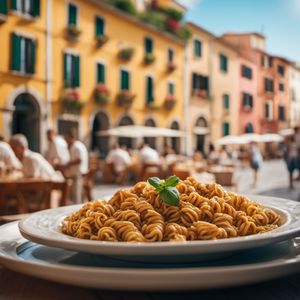
Dish
Ceremito
Ceremito is made with flour, sugar, butter, eggs, and milk. The dough is rolled out and cut into small circles. It is then baked until golden brown. Ceremito is often served with coffee or tea and is a popular treat during special occasions in Italy.
Origins and history
Ceremito has been a traditional Italian bread for centuries. It is believed to have originated in the region of Campania in the 17th century. Today, it is a popular treat during special occasions in Italy.
Dietary considerations
Not suitable for those with gluten or dairy allergies. Suitable for those without dietary restrictions.
Variations
There are many variations of Ceremito, including some that are made with dried fruit or flavored with cinnamon. Some recipes also call for the addition of nuts or chocolate chips.
Presentation and garnishing
Ceremito is traditionally served on a decorative plate or platter. It can be garnished with a dusting of powdered sugar or a dollop of whipped cream.
Tips & Tricks
To achieve the perfect texture, be sure to handle the dough gently and not overwork it. Also, be careful not to overbake the bread as it can quickly become dry.
Side-dishes
Ceremito is often served with coffee or tea. It can also be served with a glass of sweet dessert wine.
Drink pairings
Ceremito goes well with coffee, tea, or sweet dessert wine.
Delicious Ceremito recipes
More dishes from this category... Browse all »

Aachener Printen
German cuisine

Aberffraw Biscuit
Welsh cuisine

Achappam
Indian cuisine

Acıbadem kurabiyesi
Turkish cuisine

Afghan Biscuit
New Zealand cuisine

Alfajores
South American cuisine

Almendrados
Spanish cuisine

Amaretti
Italian cuisine
More cuisines from this region... Browse all »

Abruzzese and Molisan cuisine
Savory, Earthy, Rustic, Hearty

Apulian cuisine
Fresh, Savory, Rustic, Simple

Arbëreshë cuisine
Savory, Tangy, Herbaceous, Spicy

Basilicatan (Lucanian) cuisine
Savory, Earthy, Rustic, Hearty

Ligurian cuisine
Light, Delicate, Herbaceous, Salty

Lombard cuisine
Rich, Savory, Meaty, Cheesy

Neapolitan cuisine
Bold, Savory, Spicy, Tangy, Fresh

Roman cuisine
Fresh, Light, Herbaceous, Tangy, Savory

